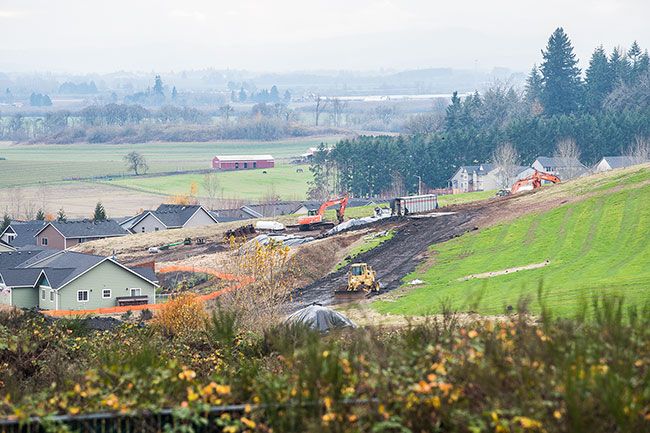Mark Davis: Growth isn’t paying its way

Guest writer Mark Davis is a retired accountant and housing authority executive. Prior to his retirement, he assisted with the development of affordable local housing with the Housing Authority of Yamhill County. He and his wife, Ellie Gunn, live on half an acre just off Cozine Creek in downtown McMinnville. They are both active in civic affairs and avid about raising their own fruits and vegetables.
The continuing population growth in McMinnville comes with costs. More residents demand more infrastructure (water, sewer, stormwater, street, sidewalk, power and transportation systems), expanded public amenities (park, library pool and community center facilities) and more public employees (police, firefighters, librarians and parks maintenance staff).
In theory, the new people coming into town should be paying for their impact on the community. In practice, it is very difficult to allocate these costs fairly, a problem compounded by the political machinations by groups with a financial interest in letting someone else pay.
One straightforward way to partially pay for growth is through System Development Charges, known as SDCs. Under the program, housing developers pay a per unit cost that goes to the city for major capital improvements.
SDCs are limited by state law to certain specific uses (park, water, sewer, stormwater and transportation) and must go to fund an approved capital improvement plan. Cities can decide which SDCs to charge at what rate.
Cities are not allowed to charge SDCs for police, fire, school or library services, even though all are forced to expand as new growth comes to a community.
McMinnville currently only charges park, sewer and transportation SDCs, although McMinnville Water & Light is currently looking into imposing a water SDC. Our total SDC amount of $8,857 is dramatically lower than most similar cities in the state and not nearly enough to cover the cost of serving new development.
A study of prior year SDCs around the state showed Wilsonville, Beaverton, Hillsboro and Lake Oswego all charged in excess of $36,000. Nearby Newberg charged $25,862.
Given that SDCs are too low, and even at their maximum level do not cover all the costs of growth, current residents and businesses are left to pick up the tab. This can take the form of increased utility rates for water and sewer or increased taxes for bond measures like the transportation bond we approved several years ago.
Each time the city of McMinnville has considered significantly raising SDCs, local developers have convinced the council that would make housing less affordable. But skyrocketing housing prices have proven the cost is being driven by market demand, not SDC rates.
To be fair, not all these increased capital expenditures are due to new residents. Some are due to deterioration of existing infrastructure assets.
The city paid for a facilities analysis that showed many of our buildings and other capital assets have not been adequately maintained due to operating budget cuts caused by property tax limitations. So now we are faced with the double whammy of fixing or replacing deteriorating assets while also subsidizing new growth not covered by SDCs.
School districts have never been allowed to charge SDCs, though the Legislature recently allowed a small fee to be charged when building permits are issued to help pay for new schools. School bond measures that tax all property owners remain the primary funding mechanism for constructing new schools required by population growth.
Because state law does not allow SDCs for amenities like the pool, library and community center, such facilities are typically financed through bond measures, supplemented by grants. In fact, a community group appointed by the city council, called MacPAC, has been diligently working for the past couple of years to come up with a plan for those very facilities.
Park SDCs raise a small fraction of the money needed to build new parks, so Parks and Recreation also looks to bond measures for major funding.
Because bond measures require voter approval, and the city is also working on creating a fire district depending on voter approval of a tax base, there appears to be little likelihood that the full MacPAC plan or the long overdue expansion of the park system will happen in the next few years.
This delay in funding new facilities is a way in which existing residents indirectly pay for growth through a decline in the quality of life.
The senior center, library, pool and community center all become more crowded, as do our parks and roads, as they try to accommodate new residents who have not contributed to building them. This leads some to lament the loss of “that small town feel.”
In McMinnville, new business construction is assessed only for sewer and roads.
This construction adds to the tax base supporting city services. However, businesses need employees, the employees need homes and those homes rely on city infrastructure, amenities and services that are currently running a deficit.
Population growth does not necessarily need to involve sprawling onto existing farmland and constructing all new public infrastructure in support.
Some of it can be accommodated by redeveloping land already in the city and taking advantage of already existing public infrastructure investment. The city’s recently approved City Center Housing Strategy is an example of how that could be implemented.
If all of this sounds difficult to resolve, let’s recall a success story.
About 25 years ago, our sewer system was failing, leading to leakage into Cozine Creek and the South Yamhill River. There was no money set aside for replacement, requiring both a city revenue bond and major rate increases to fix the system.
Today, sewage overflows into the waterways are minimal, the debt has been repaid and the sewer fund has a healthy balance to fund future expenditures, guided by a regularly updated capital improvement plan. Our sewer rates are still relatively low, compared with those of neighboring cities, and would be even lower if we charged full SDC levels for new construction.
So, yes, we can do this if we are willing to make some tough decisions.
While the topic of who pays for growth is both local and solvable, there is a related environmental crisis building that may end up extracting a price none of us can afford to pay.
In lands around the world, billions of people are trying to grow their communities just like we are. In the process, farmland is being destroyed, plant and animal species are being wiped out, forests are being exposed to fire, sea levels are rising and extreme weather events are being unleashed.
The answer to this is not as simple as raising SDCs or better allocating costs of growth to those who move here.
We must find a way for our community — and the whole world — to prosper without destroying the very ecosystems we all depend on for life itself. It is time to take seriously the old slogan, “Think globally and act locally.”








Comments
Don Dix
Mark -- the success story 25 years ago to which you refer -- in 1989 Mac began a major upgrade to the wastewater treatment system (and keep sewage from spilling in Cozine and the S. Yamhill). In 1996 (7 years later), a new system went online ($48M spent). Unfortunately, a wet period caused the new system to overflow and spill sewage.
That's when you and your wife filed a claim against the city -- and both sides agreed it was about the speed at which the city planned to reduce overflows -- all the while using necessary DEQ approval.
So, after 7 years of constructive progress, it wasn't fast enough, because of a larger than usual storm? Everyone associated (but you) agreed the claim was absurd -- and your timetable was not substantially different than planned.
Supporting this article with 'your success story' seems a little smug and self-congratulatory without reporting all the facts involved, wouldn't you say?
Tom Hammer
In the last 40 years Oregon has reduced farmland 10% while increasing farm output 30%. Is that what is meant by destroying farmland?